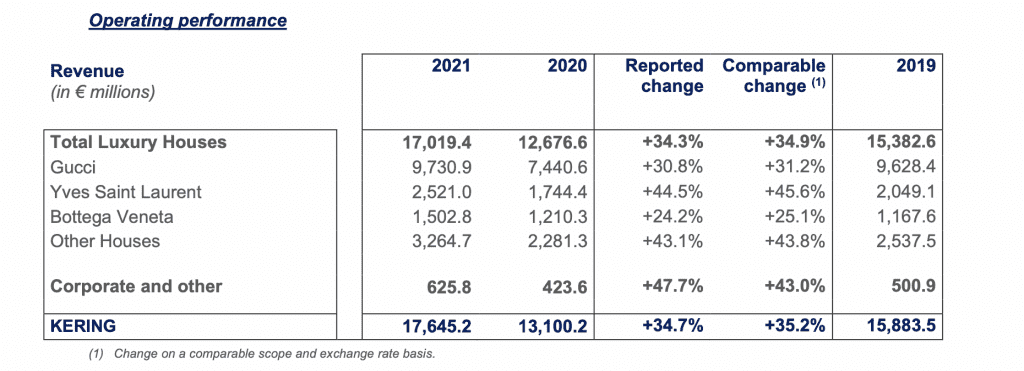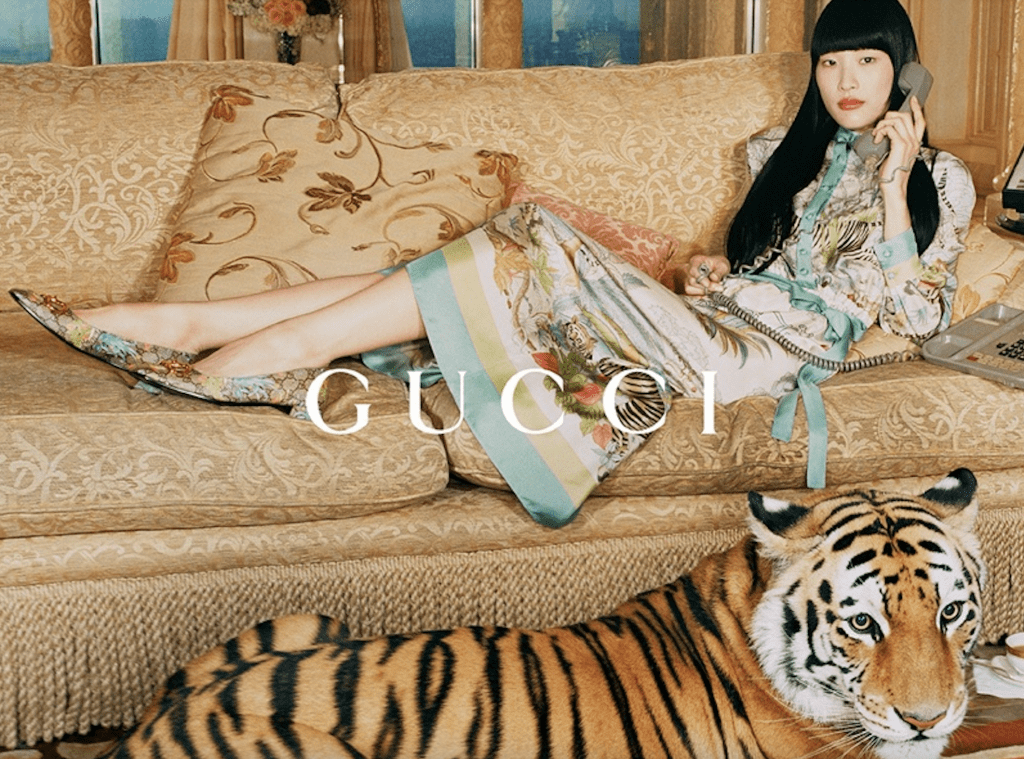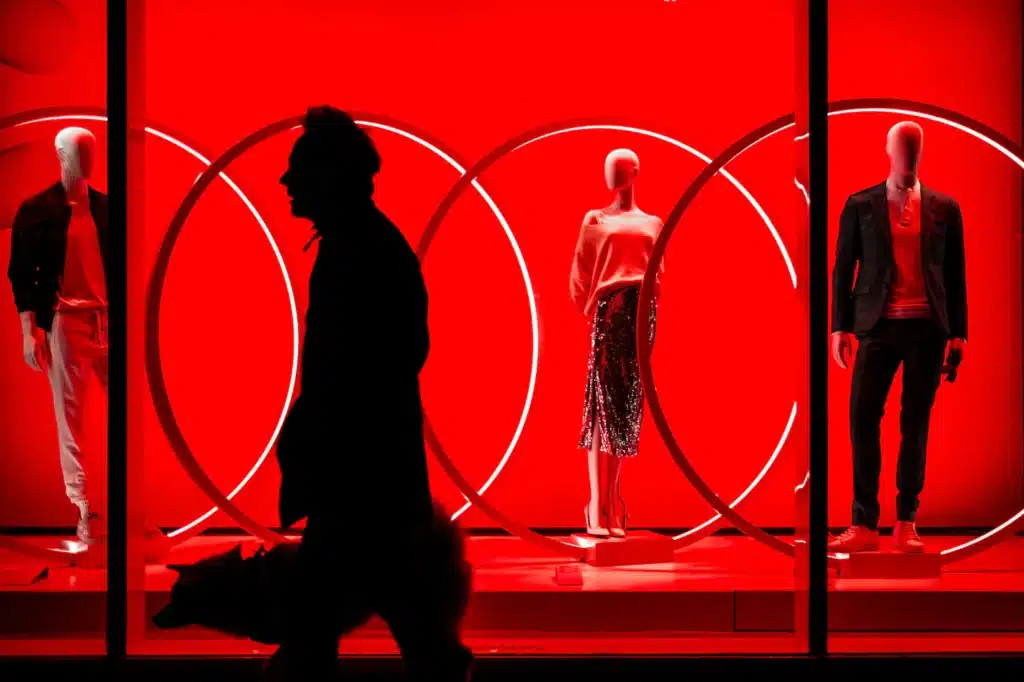All of Kering’s brands saw “sharp sales rebounds” in 2021, the French luxury goods group revealed on Thursday, noting that revenue was “way beyond 2019 levels.” In its full-year report, Kering revealed that its sales grew by 35 percent and 13 percent compared to 2020 and 2019 to €17.6 billion ($20.01 billion). Meanwhile, the François-Henri Pinault-led group – which owns Gucci, Balenciaga, Bottega Veneta, and Saint Laurent, among other brands – reported that recurring operating income “rose sharply,” by 60 percent compared to 2020, to reach a new record of €5.02 billion ($5.71 billion), and recurring operating margin “retrieved a high level” at 28.4 percent.
Looking at the group’s individual product categories, Leather Goods represented 50 percent of Kering’s revenue in 2021 (down from 52% in 2020 and 55% in 2019), and was “probably one of the categories most exposed to fluctuations in tourism,” which is why it “posted weaker sales growth than the other categories.” Kering noted that its Leather Goods performance “should be analyzed in the view of the very high base for comparison in 2019, as well as the houses’ prudent inventory management in 2020, which led them to limit the number of product lines and amount of stock available in stores in 2020 and for part of 2021.” Shoes followed with 21 percent of sales for 2021 (up from 21% in 2020 and 18% in 2019), and then ready-to-wear, which generated 15 percent of sales (the same as 2020 and up 1% from 2019).
Sales for the group came primarily from the Asia-Pacific region, which generated 39 percent of sales in 2021, followed by 27 percent from North America, and Western Europe, which generated 22 percent of Kering revenue, and from its own retail operations. “Distribution is becoming increasingly exclusive, which means that the revenue contribution of the wholesale channel is gradually decreasing,” per Kering, which reported that 81 percent of 2021 revenues came from retail, with retail sales increasing by 40 percent year-over-year and 18 percent from 2019. (Brands across the board appear to be using the pandemic period as a time to drive home existing distribution restructuring efforts.)
Still yet, e-commerce continues to grow for the group, with online sales topping $2 billion in 2022, with online revenue growing by 55 percent year-over-year.

Gucci
Delving into its three biggest brands, Kering reported that Gucci – which drives the bulk of Kering’s sales and whose prices have on average been boosted substantially – enjoyed “a year of sustained growth.” The Italian brand’s revenues in Q4, alone, grew by 32 percent, quite a jump from analysts’ expectations of 18 percent. The quarterly sales boost came from “the success of its iconic lines, along with an intense schedule of events and new product launches,” including for Aria, the brand’s Balenciaga mashup collection. For the year, Gucci’s revenue rose 31 percent to €9.73 billion ($11.07 billion). Gucci’s recurring operating margin rose by 3.1 points to 38.2 percent.
An interesting note about the Aria collection, according to a note from Bernstein on Thursday: Sales of Aria products in Gucci stores are accounted for as revenues for Gucci and sales in Balenciaga stores as Balenciaga revenues. However, the majority of sales are Gucci due to its relative size and retail footprint.
In a nod to its enduring effort to overhaul its distribution and phase out much of its wholesale efforts and focus on its own retail sales (a whopping 91% of sales came from directly operated stores in 2021), Gucci’s 2021 retail network sales grew 37 percent and 10 percent compared to 2020 and 2019, respectively, and wholesale revenue was down by 10 and 39 compared to 2020 and 2019. (Gucci is the first Kering name to embark on a drastic wholesale “streamlining,” and should complete this effort within 2022.)
As for Gucci’s sales by region, Kering stated that sales in 2021 rebounded “very strongly” in North America, growing by almost 67 percent compared to both 2020 and 2019. Revenues from North America account for 27 percent of sales, topped by Asia-Pacific with 44 percent. Growth in the Asia-Pacific region grew 29.5 percent year-on-year, with regional growth mainly driven by Mainland China, which saw firm increases in both online and in-store sales.
In a corresponding earnings call on Thursday, Kering management stated that Gucci’s growth is expected to carry on through 2022, which will see the brand continue to increase prices and boost its product mix, including by way of more Aria-like drops in stores.
Saint Laurent
Kering reported Saint Laurent generated €2.52 billion ($2.86 billion) in revenue for the year, up 45.6 percent and 26 percent at constant exchange rates relative to 2020 and 2019 respectively, driven by sales in North America (34%), Asia-Pacific (28%), and Western Europe (27%). Sales from directly operated stores “grew sharply” in 2021, up 55 percent compared to 2020 and 35 percent over two years, per Kering, while wholesale revenue was 23 percent higher than in 2020 and 6 percent higher than in 2019, as the brand “also started streamlining its third-party distribution.”
For the product breakdown, sales at Saint Laurent, which is Kering’s second-largest house, are driven significantly by leather goods (a striking 72%), followed by ready-to-wear (12%), and footwear (9%), and the Kering noted that online sales proved to be a significant driver of sales, growing for a third year in a row.
Saint Laurent is garnering a lot of attention from Kering management, which said on Thursday that it is the next house to join the realm of the “mega-brands,” particularly as its growth potential is “highly underestimated,” including in China. In short: the brand is on an “exceptional growth path.”
Bottega Veneta
Bottega Veneta’s 2021 revenue hit an “all time high” of €1.5 billion ($1.71 billion), up 25 percent compared to 2020 and 32 percent compared to 2019, with sales driven by Asia, where its desirability has continue to increase (39%), Western Europe (24%), and then North America (18%). According to Kering, “Trends that emerged in 2020 were confirmed in 2021: in Western Europe and North America – where local customers were the first to be won over by the House’s new creative direction – sales were very strong throughout the year. Bottega Veneta’s desirability also continued to increase in Asia.” Kering highlighted the brand’s success in North America, in particular, where sales were up by 83.3 percent compared to 2020 and 67 percent compared to 2019. “This is an outstanding performance given the House’s market position and its offering, which is generally less aspirational than that of other Group brands.”
With a category breakdown that somewhat mirrors Saint Laurent’s, Bottega generates 71 percent of sales from its leather goods, followed by 18 percent from shoes, and 9 percent from ready-to-wear.
Management’s focus here appeared to be on the “confirmed potential” of Bottega as a key brand, and against that background, plans to boost profitability. Kering stated that profitability for Bottega “is expected to continue improving gradually.” Margins came to 19.1 percent (up 4.9 points from 2020 and up 0.7 points from 2019), an increase that was driven by “positive operational leverage, even though the house invested heavily in 2021 to make its revamp a lasting success.”
Other Houses
Balenciaga had “another record year,” per Kering. “In particular, the leather goods offerings of Balenciaga and Alexander McQueen expanded and attracted new customers. As a result, sales in that category grew strongly.” Ready-to-wear “also delivered rapid sales growth, primarily driven by menswear collections,” while “shoes once again saw particularly strong growth in 2021, driven by the appeal of the Balenciaga and Alexander McQueen collections.”
Reflecting on the year, Kering stated that among other things, Balenciaga, which is “gaining in distinctiveness and prestige,” has been “exploring new business models and developing new modes of engagement,” the latter of which has included an influx of Kardashian and Kanye West marketing.
M&A and Metaverse
During Thursday’s call, Pinault shed light on future M&A, stating that Kering’s “portfolio of brands is not perfect, so I can improve it significantly going forward.” The group is actively scoping out acquisition targets based on “patience, being opportunistic and most importantly, being lucid.” As for the metaverse, Kering’s chairman asserted that the group is “considering how the virtual world could potentially disrupt e-commerce,” as well as provide more opportunities for it to extend its products. At the same time, CNBC notes that Pinault revealed that Kering is considering how it could accept cryptocurrency as a payment at some point going forward.











